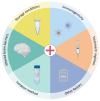Special delEVery: Extracellular Vesicles as Promising Delivery Platform to the Brain
- PMID: 34829963
- PMCID: PMC8615927
- DOI: 10.3390/biomedicines9111734
Special delEVery: Extracellular Vesicles as Promising Delivery Platform to the Brain
Abstract
The treatment of central nervous system (CNS) pathologies is severely hampered by the presence of tightly regulated CNS barriers that restrict drug delivery to the brain. An increasing amount of data suggests that extracellular vesicles (EVs), i.e., membrane derived vesicles that inherently protect and transfer biological cargoes between cells, naturally cross the CNS barriers. Moreover, EVs can be engineered with targeting ligands to obtain enriched tissue targeting and delivery capacities. In this review, we provide a detailed overview of the literature describing a natural and engineered CNS targeting and therapeutic efficiency of different cell type derived EVs. Hereby, we specifically focus on peripheral administration routes in a broad range of CNS diseases. Furthermore, we underline the potential of research aimed at elucidating the vesicular transport mechanisms across the different CNS barriers. Finally, we elaborate on the practical considerations towards the application of EVs as a brain drug delivery system.
Keywords: brain barriers; brain targeting; drug delivery; extracellular vesicles; neurological disorders.
Conflict of interest statement
The authors declare no conflict of interest.
Figures



Similar articles
-
Choroid plexus-derived extracellular vesicles exhibit brain targeting characteristics.Biomaterials. 2022 Nov;290:121830. doi: 10.1016/j.biomaterials.2022.121830. Epub 2022 Oct 6. Biomaterials. 2022. PMID: 36302306
-
Extracellular Vesicles as Drug Delivery Vehicles to the Central Nervous System.J Neuroimmune Pharmacol. 2020 Sep;15(3):443-458. doi: 10.1007/s11481-019-09875-w. Epub 2019 Sep 4. J Neuroimmune Pharmacol. 2020. PMID: 31485884 Review.
-
Stem Cell-derived Extracellular Vesicles: A Promising Nano Delivery Platform to the Brain?Stem Cell Rev Rep. 2023 Feb;19(2):285-308. doi: 10.1007/s12015-022-10455-4. Epub 2022 Sep 29. Stem Cell Rev Rep. 2023. PMID: 36173500 Review.
-
Intranasal delivery of extracellular vesicles: A promising new approach for treating neurological and respiratory disorders.J Control Release. 2025 Mar 10;379:489-523. doi: 10.1016/j.jconrel.2025.01.018. Epub 2025 Jan 18. J Control Release. 2025. PMID: 39800240 Review.
-
Extracellular vesicles: Novel promising delivery systems for therapy of brain diseases.J Control Release. 2017 Sep 28;262:247-258. doi: 10.1016/j.jconrel.2017.07.001. Epub 2017 Jul 4. J Control Release. 2017. PMID: 28687495 Review.
Cited by
-
Stem cell-derived extracellular vesicle therapy for acute brain insults and neurodegenerative diseases.BMB Rep. 2022 Jan;55(1):20-29. doi: 10.5483/BMBRep.2022.55.1.162. BMB Rep. 2022. PMID: 35000673 Free PMC article. Review.
-
Pharmacokinetics and biodistribution of extracellular vesicles administered intravenously and intranasally to Macaca nemestrina.J Extracell Biol. 2022 Oct;1(10):e59. doi: 10.1002/jex2.59. Epub 2022 Oct 11. J Extracell Biol. 2022. PMID: 36591537 Free PMC article.
-
Human Epidural AD-MSC Exosomes Improve Function Recovery after Spinal Cord Injury in Rats.Biomedicines. 2022 Mar 15;10(3):678. doi: 10.3390/biomedicines10030678. Biomedicines. 2022. PMID: 35327480 Free PMC article.
-
Extracellular Vesicles as Therapeutic Resources in the Clinical Environment.Int J Mol Sci. 2023 Jan 25;24(3):2344. doi: 10.3390/ijms24032344. Int J Mol Sci. 2023. PMID: 36768664 Free PMC article. Review.
-
Estimating progression of Alzheimer's disease with extracellular vesicle-related multi-omics risk models.Front Aging Neurosci. 2025 Jul 24;17:1617611. doi: 10.3389/fnagi.2025.1617611. eCollection 2025. Front Aging Neurosci. 2025. PMID: 40778305 Free PMC article.
References
-
- Thery C., Witwer K.W., Aikawa E., Alcaraz M.J., Anderson J.D., Andriantsitohaina R., Antoniou A., Arab T., Archer F., Atkin-Smith G.K., et al. Minimal information for studies of extracellular vesicles 2018 (MISEV2018): A position statement of the International Society for Extracellular Vesicles and update of the MISEV2014 guidelines. J. Extracell. Vesicles. 2018;7:1535750. doi: 10.1080/20013078.2018.1535750. - DOI - PMC - PubMed
Publication types
Grants and funding
LinkOut - more resources
Full Text Sources

